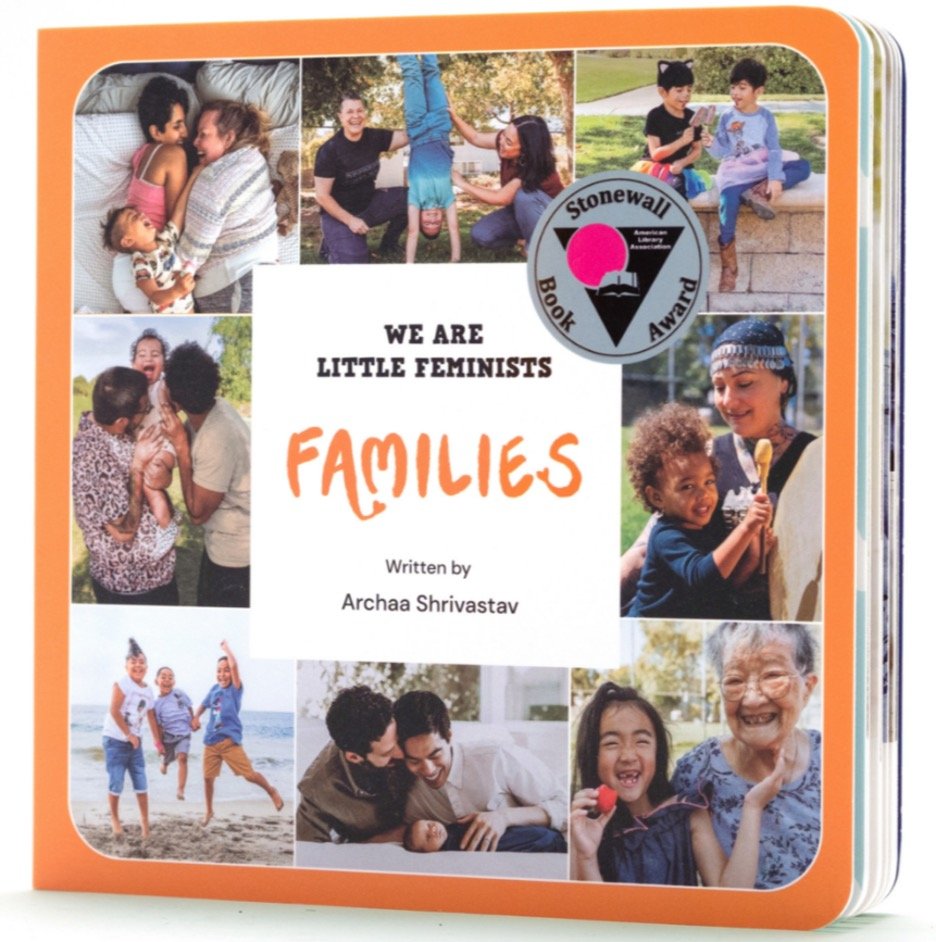Process Talk with Jen: Archaa Shrivastav on Families
[Posted by Jen Breach for Writing with a Broken Tusk]
The Stonewall-Mike Morgan and Larry Romans Children’s and Young Adult Literature Award and Honors are “given annually to English-language works of exceptional merit for children or teens relating to the gay, lesbian, bisexual and transgender experience”. When We Are Little Feminists: Families won the award in 2021–the first and to date only board book winner or honoree–the committee wrote:
“Beautiful photos of real-life families showcase all the wonderful forms of family, while poetic text builds both vocabulary and family connection. Families helps families and educators celebrate gender and ethnicity at home and in the classroom. Understanding queer identities and representation can be this simple.”
I am delighted to speak with writer Archaa Shrivastav about this surprising, joyful celebration of real-life diversity.
[JEN] Families is one of three books you wrote for the “We Are Little Feminists” board book series–Hair showcases racial and cultural diversity and traditions, and On the Go showcases all kinds of movement and mobility aids. How did you approach these three focal points to highlight intersectionality?
[ARCHAA] Gender & sexuality, race, and disability are three intersectional identities that are rarely represented authentically in board books. They also can be more concrete to visually identify, though not all the identities within these categories are visible. In curating and writing these books, I aimed to highlight real people, especially BIPOC folx, who identify across the spectrum of these identities. There is so much intersectionality within these books; many of the queer families are BIPOC, and families with disabilities often also have queer identities. Rather than isolate each identity into silos, I wanted to create books that emphasize the breadth of diversity and intersectionality within each category, showing that these identities coexist and intersect in beautiful, real-life ways. This approach not only celebrates diversity but also fosters a deeper understanding and appreciation for the interconnectedness of these identities.
[JEN] Families includes fourteen bright and joyful photos of real life families of all kinds of configurations and situations. There are no labels. It’s a masterclass in showing, not telling, and in showing the universal through specifics. How on earth did you select the final fourteen that, together, make intersectional representation seem so simple and obvious?!
[ARCHAA] Thank you for your kind words; I'm genuinely happy to know that the sentiment I hoped to convey came through. There were several factors involved in photo curation: the families needed to include members who identified as LGBTQIA+, I needed to obtain their permission to use the photos, and the photos had to be high quality. Beyond those logistics, I aimed for a diverse visual representation, encompassing various gender expressions, skin tones, and body sizes.
After curating an initial set of photos, I identified gaps in representation and collaborated with my publisher to arrange a photoshoot with real families. I invited many members of my queer community to participate. Through time, talented photography, and the generous sharing of time and photos from families, I arrived at this stellar selection.
“These books center children, allowing young readers to connect deeply to each page, while inviting adults to ask open-ended questions that spark dialogue, examine biases, and foster ongoing conversations.”
However, I’ve learned from the process. If I were to do it again, I would ensure that all families and photographers are fairly compensated for their photos, something I advocated for with my publisher, especially after winning the Stonewall Award, but ultimately did not achieve. I would also focus more on gender representation and work with transgender and nonbinary individuals to ensure authentic representation of gender diversity in these books.
[JEN] You approached this so thoroughly and with so much heart. I can’t wait to see what you bring this spirit to next.
It’s easy to see that while this is a board book for 0-5 year olds, it is actually for literally every reader. How is this project in conversation with your other social justice and anti-racism work?
[ARCHAA] A lot of my work involves supporting adults in talking to kids about topics like racism, transphobia, ableism, and more. This book serves as a literal conversation starter. It's especially valuable for families without LGBTQIA+ parents or caregivers who want to provide their children with an expansive and inclusive worldview around gender and sexuality. These books center children, allowing young readers to connect deeply to each page, while inviting adults to ask open-ended questions that spark dialogue, examine biases, and foster ongoing conversations.
However, this book is not an answer or solution but a tool in the ongoing work of challenging assumptions and biases and undoing the heteronormative patriarchy that our families and children are steeped in.
[JEN] Very well said, and a timely and important mission for writers of books for children, and their grownups.
Every book teaches the writer something. What did you learn from writing this project?
[ARCHAA] I learned about the importance of authentic relationships when creating work that represents a broad community. My community is what made this book come alive, they are on the pages of this book, and I'm deeply grateful to them. I hope to be able to work with even more folx in the queer community to create more books like this and to work in structures and systems that equitably compensate all the creators and contributors.

